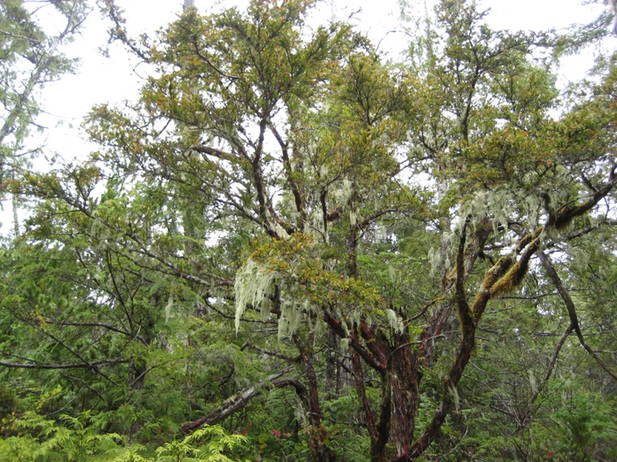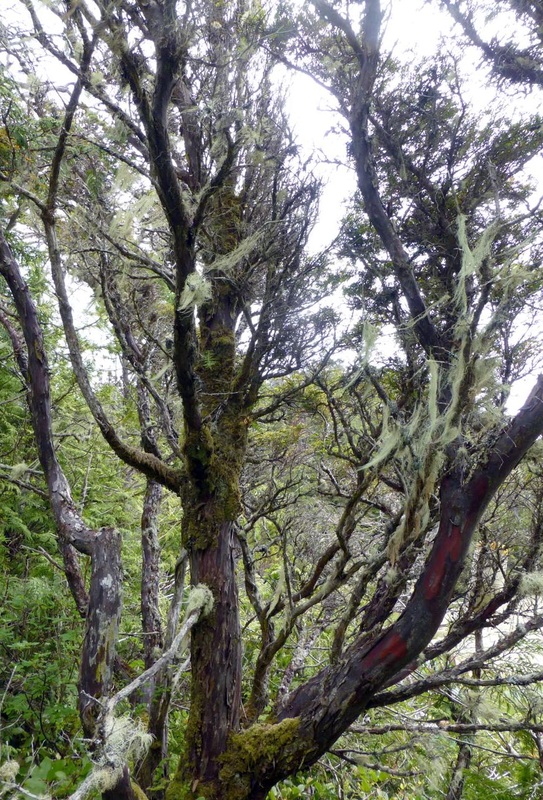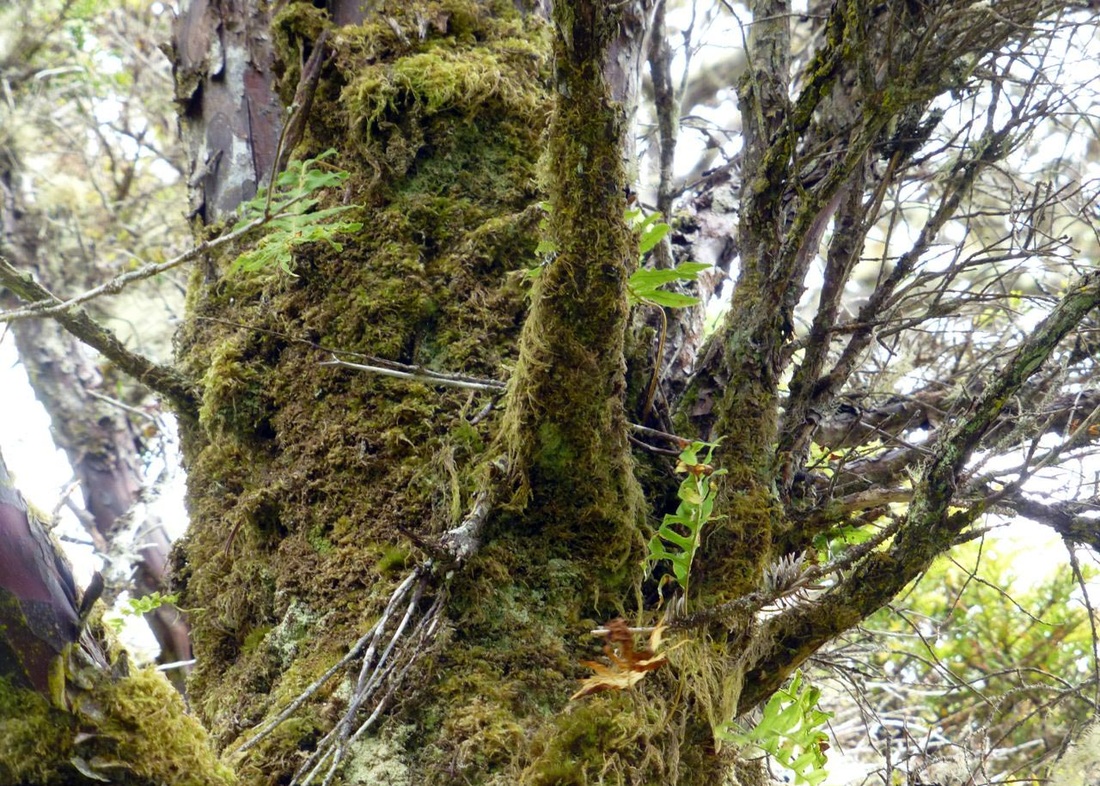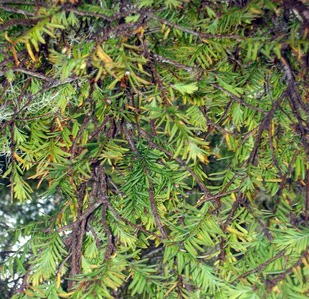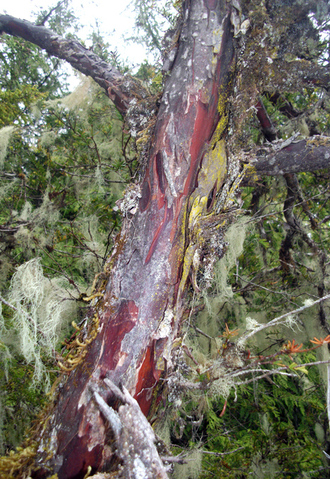Western yew, Pacific yew • Taxus brevifolia • Nuxalk - kuts'ulhkw
Identification
The Western or Pacific yew is a small tree or large shrub, reaching heights of 2-15 m. Younger trees tend to have a spreading, squarish appearance, while older trees may have a more typical conifer-like cone shape. Western yew is most identifiable by its thin, reddish, and papery outer bark which tends to peel away, giving the tree a shredded appearance. The needles are flat and do not taper until the very tip, where they come to a point. They have a flat arrangement along the stem. The western yew is unusual in that it is a conifer that produces berries instead of cones. The berries are bright red, similar to a huckleberry. ***NOTE: unlike huckleberries, yew berries are poisonous to humans!***
Habitat & Range
The habitat in which western yew is found varies somewhat across its range. On the Central Coast it generally occurs in low-elevation open forests of western hemlock and western redcedar, as a shrubby understory or mid-canopy tree.
The western yew's range extends along the Pacific coast from Alaska south to California. The range gets narrower towards the north. There is also an isolated population stretching from southeastern BC south to parts of Idaho, eastern Washington, and northwestern Montana.
Similar Species
This tree has a more yellowy appearance than hemlock or Douglas-fir. While mountain hemlock (Tsuga mertensiana) has needles that attach to branches at all angles, western hemlock (T. heterophylla) needles have a flat arrangement like western yew. The trees can be distinguished by the differences in their bark (western hemlock bark is thick, furrowed, and less red) and by their structure: western hemlock tends to be more cone-shaped and less spreading, and has a drooping leader (top).
Human Uses
Western yew has been used extensively by humans in the past and present. Yew wood is very hard and durable, and also highly polishable, making it perfect for carving and creating working implements. Yew wood was used to make bows by many First Nations of the Pacific Northwest, and was traded to groups in the interior as well. Other items that were traditionally made with yew wood include paddles, spears, needles, boxes, dowels and combs. Yew wood is still valued by woodcarvers.
Despite being poisonous, the fruits of yew trees were traditionally eaten — but not in great quantities. Dried yew needles were often smoked in combination with kinnikinnick, a strong and potentially lethal combination.
An anti-cancer drug called taxol was isolated from western yew bark in the late 1900s. This discovery resulted in heavy exploitation of this species throughout much of its range. A method to derive the compound from other, more abundant yew species has since been developed, thus easing the pressure on western yew — a species that is already vulnerable to habitat destruction via logging, particularly because of its slow growth rates and susceptibility to fire. Demand for taxol will likely remain a threat to this and other yew species. Indeed, the majority of Asian yew species are listed as Threatened by the IUCN Red List of Threatened Species.
iNaturalist
https://www.inaturalist.org/taxa/55209-Taxus-brevifolia
The Western or Pacific yew is a small tree or large shrub, reaching heights of 2-15 m. Younger trees tend to have a spreading, squarish appearance, while older trees may have a more typical conifer-like cone shape. Western yew is most identifiable by its thin, reddish, and papery outer bark which tends to peel away, giving the tree a shredded appearance. The needles are flat and do not taper until the very tip, where they come to a point. They have a flat arrangement along the stem. The western yew is unusual in that it is a conifer that produces berries instead of cones. The berries are bright red, similar to a huckleberry. ***NOTE: unlike huckleberries, yew berries are poisonous to humans!***
Habitat & Range
The habitat in which western yew is found varies somewhat across its range. On the Central Coast it generally occurs in low-elevation open forests of western hemlock and western redcedar, as a shrubby understory or mid-canopy tree.
The western yew's range extends along the Pacific coast from Alaska south to California. The range gets narrower towards the north. There is also an isolated population stretching from southeastern BC south to parts of Idaho, eastern Washington, and northwestern Montana.
Similar Species
This tree has a more yellowy appearance than hemlock or Douglas-fir. While mountain hemlock (Tsuga mertensiana) has needles that attach to branches at all angles, western hemlock (T. heterophylla) needles have a flat arrangement like western yew. The trees can be distinguished by the differences in their bark (western hemlock bark is thick, furrowed, and less red) and by their structure: western hemlock tends to be more cone-shaped and less spreading, and has a drooping leader (top).
Human Uses
Western yew has been used extensively by humans in the past and present. Yew wood is very hard and durable, and also highly polishable, making it perfect for carving and creating working implements. Yew wood was used to make bows by many First Nations of the Pacific Northwest, and was traded to groups in the interior as well. Other items that were traditionally made with yew wood include paddles, spears, needles, boxes, dowels and combs. Yew wood is still valued by woodcarvers.
Despite being poisonous, the fruits of yew trees were traditionally eaten — but not in great quantities. Dried yew needles were often smoked in combination with kinnikinnick, a strong and potentially lethal combination.
An anti-cancer drug called taxol was isolated from western yew bark in the late 1900s. This discovery resulted in heavy exploitation of this species throughout much of its range. A method to derive the compound from other, more abundant yew species has since been developed, thus easing the pressure on western yew — a species that is already vulnerable to habitat destruction via logging, particularly because of its slow growth rates and susceptibility to fire. Demand for taxol will likely remain a threat to this and other yew species. Indeed, the majority of Asian yew species are listed as Threatened by the IUCN Red List of Threatened Species.
iNaturalist
https://www.inaturalist.org/taxa/55209-Taxus-brevifolia
References
Pojar, J. and MacKinnon, A. (2005). Plants of Coastal British Columbia, Revised. Vancouver, BC: Lone Pine Publishing. P. 40.
Thomas, P. 2013. Taxus brevifolia. The IUCN Red List of Threatened Species 2013: e.T34041A2841142. Accessed 05/01/2016.
Authors and editors of page
Chanda Brietzke and Brian Starzomski (2013).
Pojar, J. and MacKinnon, A. (2005). Plants of Coastal British Columbia, Revised. Vancouver, BC: Lone Pine Publishing. P. 40.
Thomas, P. 2013. Taxus brevifolia. The IUCN Red List of Threatened Species 2013: e.T34041A2841142. Accessed 05/01/2016.
Authors and editors of page
Chanda Brietzke and Brian Starzomski (2013).
